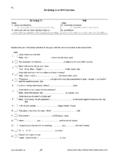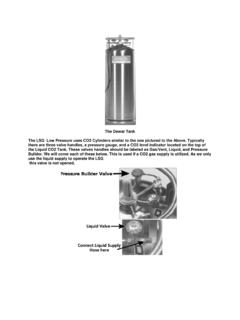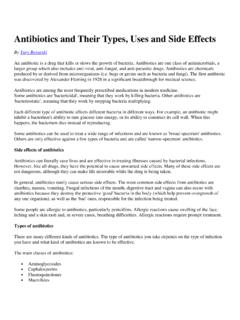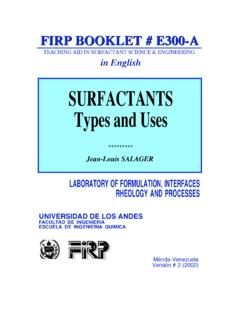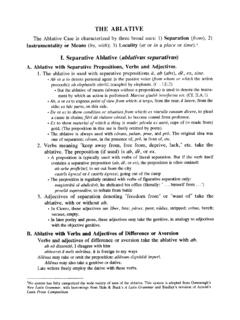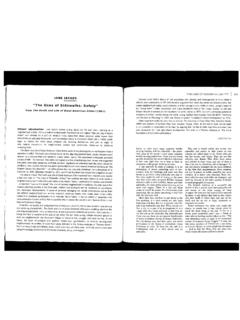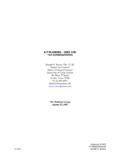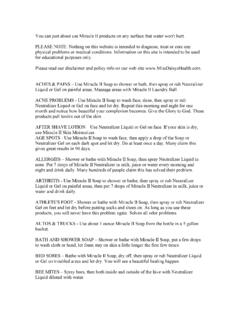Transcription of Multiple uses of water - Food and Agriculture Organization
1 Multiple uses of water FAO. IRRIGATION. AND. DRAINAGE. services in large PAPER. 67. irrigation systems Auditing and planning modernization The MASSMUS Approach by Daniel Renault Land and water Division FAO. Robina Wahaj Technical Officer Land and water Division FAO. Stef Smits International water and Sanitation Centre (IRC), The Hague, The Netherlands FOOD AND Agriculture Organization OF THE UNITED NATIONS. Rome, 2013. The designations employed and the presentation of material in this information product do not imply the expression of any opinion whatsoever on the part of the Food and Agriculture Organization of the United Nations (FAO) concerning the legal or development status of any country, territory, city or area or of its authorities, or concerning the delimitation of its frontiers or boundaries.
2 The mention of specific companies or products of manufacturers, whether or not these have been patented, does not imply that these have been endorsed or recommended by FAO in preference to others of a similar nature that are not mentioned. The views expressed in this information product are those of the author(s) and do not necessarily reflect the views or policies of FAO. ISBN 978-92-5-107887-7 (print). E-ISBN 978-92-5-107888-4 (PDF). FAO, 2013. FAO encourages the use, reproduction and dissemination of material in this information product. Except where otherwise indicated, material may be copied, downloaded and printed for private study, research and teaching purposes, or for use in non-commercial products or services, provided that appropriate acknowledgement of FAO as the source and copyright holder is given and that FAO's endorsement of users' views, products or services is not implied in any way.
3 All requests for translation and adaptation rights, and for resale and other commercial use rights should be made via request or addressed to FAO information products are available on the FAO website ( publications) and can be purchased through Table of contents iii Table of contents List of Tables ix List of Figures xii List of Boxes xiv List of Photographs xv Acknowledgements xviii Foreword xix MASSMUS Prologue xx LIST of ACRONYMS and SYMBOLS xxii INTRODUCTION to the Audit of Multiple Services Systems xxiv PART ONE. 1. Conceptual framework for Multiple water services 1. Framework for approaches and scales 2. water management for MUS and IWRM 5. Multiple uses practices and services 6. Different MUS systems 7.
4 Definition and approach to services' for water systems 8. The MASSMUS concept of water services 9. Direct and indirect services 11. Ecosystem services generated by field irrigation practices 11. Service approach from the viewpoint of management 12. Elements composing the service 15. Service attributes target, tolerance and default management 15. iv Multiple uses of water services in large irrigation systems 2. MASSMUS APPROACH to the OPEN CHANNEL SYSTEM 18. MASSMUS PHASE A Baseline information 21. MASSMUS Phase B Elements used to identify water services 32. User's shares in financing MOM MASSMUS Phase C Vision and Modernization 51. PART TWO: Detailed approach to each water service 61. 3. Direct distributed services to Agriculture users Irrigation 63.
5 Description of the service and its users or beneficiaries 63. Irrigation delivery services 64. Capacity associated with the irrigation service 68. Sensitivity associated with the service 68. Perturbations associated with the service 69. water share 69. Benefits 70. Cost 70. Management unit 70. Demand for operation 72. 4. Direct distributed services to Agriculture users: Livestock 75. Description of the service and its users or beneficiaries 76. Capacity associated with the service 77. Sensitivity associated with the service 77. Perturbation associated with the service 77. water share (accounting) 77. Estimating the benefits 77. Cost analysis 79. Management 79. Demand for Operation 79. Table of contents v 5.
6 Direct Distributed Service to Agriculture : Aquaculture 81. Description of the service and its users or beneficiaries 83. Capacity, sensitivity and perturbation associated with the service 84. water share (accounting) 85. Estimation of the benefits 85. Cost for operation 87. Management 87. Demand for Operation 87. 6. Direct Distributed Services for Domestic water 88. Description of the service and its users or beneficiaries 88. Capacity associated with the service 95. Sensitivity associated to the service for domestic purpose 95. Perturbations associated with the service 95. water share 96. Estimating the benefits of domestic water services 96. Cost analysis 98. Management 98. Demand for Operation 98.
7 7. Direct Distributed Services to Small Industry and Business 101. Description of the service and its users or beneficiaries 101. Capacity, Sensitivity and Perturbation associated with the service 102. water share 102. Values and cost 102. Management 102. Demand for Operation 102. 8. Indirect Distributed Services to Homestead Garden 104. Description of the service and its users or beneficiaries 104. Capacity associated with the service to homestead garden 106. vi Multiple uses of water services in large irrigation systems Sensitivity associated with the service to homestead garden 106. Perturbations 106. water share (accounting) 106. Benefits and values: accounting for the provisioning services 107.
8 Cost analysis and demand for operation 107. Management 107. 9. Indirect Distributed Services to Perennial Natural Vegetation 109. Description of the service and its users or beneficiaries 109. Capacity, sensitivity and perturbation associated with the service 109. water share (accounting) 109. Estimating the benefits 110. Cost and demand for operation 110. Management Organization and improvements 110. 10. Direct Service to Hydro-power Plants 111. Description of the service and its users or beneficiaries 111. Capacity associated with the service 111. Sensitivity and perturbations 112. water share 112. Benefits - Electricity production: only a small share of the benefit 112. Costs 113. Management 113.
9 Demand for Operation 113. 11. Direct Raw water Service to Cities and Large Industry 114. Description of the service and its users or beneficiaries 114 12. Service for Capture Fisheries in water Bodies and Streams 116. Description of the service and its users or beneficiaries 117. Table List ofoftables contents vii Capacity, Sensitivity and Perturbation 119. water share (accounting) 119. Benefits 119. Cost for operation 121. Management 122. Demand for operation 122. 13. Cultural Services: Recreational, Social, Cultural and Tourism 123. Description of the service and its users or beneficiaries 123. Capacity, sensitivity and perturbations 125. water share (accounting) 125. Benefits of cultural services 125.
10 Management 125. Demand for operation 125. 14. Environmental Services 127. Description of the service and its users or beneficiaries 127. Capacity, sensitivity and perturbation associated with the service 129. water share (accounting) 129. Values and cost 130. 15. Other Provisioning Services: Transport 133. Description of the service and its users or beneficiaries 133. Capacity, sensitivity and perturbation associated with the service 133. water share (accounting) 133. Benefits and cost 134. Management 134. Demand for Operation 134. viii Multiple uses of water services in large irrigation systems 16. Other Regulating Services: Flood Protection, Drainage 135. Description of the service and its users or beneficiaries 135.










